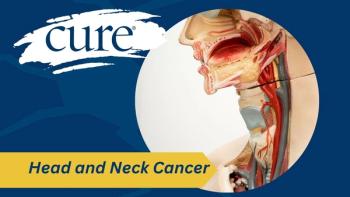
Getting a Diagnosis of Head and Neck Cancer

Transcript:
Meryl Kaufman, M.Ed., CCC-SLP, BRS-S: When we talk about the HPV-related cancers, those are primarily in the oropharynx, which is the tongue base and the tonsil. But the traditional cancers typically can also involve the tongue, the lips, the floor of the mouth, the jaw, the gums and the hard palate. And the pharynx; that includes the nasopharynx behind the nose. We’ve addressed the oropharynx but also the hypopharynx, near the larynx. And in your case, laryngeal cancer that involves the larynx, the voice box, and the epiglottis. So, head and neck cancers can occur in any of those places. Can you talk about some of the signs and symptoms people can look out for in those areas?
Itzhak Brook, M.D., M.Sc.: Well, the important signs that are common to oral cancers are having a sore throat, a feeling that you cannot swallow and difficulty in swallowing. In advanced stages, it can interfere with breathing. If you have increased lymph glands in the neck and are also feeling like a lump or something is stuck in your mouth, those could be a sign. Sometimes they have symptoms such as pain in the ear or pain in the throat. And there are specific cancers such as sinuses and lips. If there is an area of the mouth where there’s a red or ulcerating lesion in the oropharynx, this can indicate that there is a cancer risk.
Meryl Kaufman, M.Ed., CCC-SLP, BRS-S: Exactly. Can you talk about your initial presentation? What symptoms did you experience?
Itzhak Brook, M.D., M.Sc.: I experienced something stuck in my mouth, and when it didn’t go away after a week or so, I went to see my doctors, and they discovered it very early. And I was fortunate that it was possible to remove it by a simple biopsy. And then, unfortunately for me, even though I got radiation, the cancer came back about a year and a half later, and I required a laryngectomy to remove the cancer because it had moved to other places, the throat. And that was a way to treat it initially, but being vigilant and recognizing early that there’s something wrong, something is happening, can definitely save many lives.
Meryl Kaufman, M.Ed., CCC-SLP, BRS-S: Exactly. And quality of life, right?
Itzhak Brook, M.D., M.Sc.: Right.
Meryl Kaufman, M.Ed., CCC-SLP, BRS-S: What were some of the tests exactly that you underwent in trying to find this cancer and making a diagnosis?
Itzhak Brook, M.D., M.Sc.: Well, I got obviously the most important thing, which was to have a good otolaryngological examination with endoscopy, where they put the tube into your throat or through the nose to try to detect and see what’s going on through direct examination. The other tests that I am aware of are MRI and then CT. But the most important thing in my case was a good physical examination because in my case, the MRI and CT didn’t show anything wrong because you need the cancer to be larger than about a half an inch, and mine wasn’t yet. So, seeing your doctor is the most important thing a person can do to catch the cancer early.
Meryl Kaufman, M.Ed., CCC-SLP, BRS-S: Absolutely. And one of the things the Head and Neck Cancer Alliance does and promotes is free screenings throughout the country and throughout the world. And traditionally, the Head and Neck Cancer Alliance has done that during oral head and neck cancer awareness week, which occurs in April every year. But there has been a push in the past couple of years to really spread that out throughout the year and help raise awareness to these signs and symptoms that you addressed, as well as direct patients to facilities that can provide a screening. And a screening is simple and easy, and it does involve a physical examination—feeling the neck, looking for signs and symptoms and talking about signs and symptoms. So. certainly, if any listeners were to identify any of these risk factors that you address, such as a change in swallowing, a change in voice, a lump in the neck, pain in the ear or difficulty breathing, then certainly looking to some of these screening sites or reaching out to your doctor is a good way to really find those cancers early and help minimize the intensity of the treatment that might result.
Itzhak Brook, M.D., M.Sc.: Absolutely.
Meryl Kaufman, M.Ed., CCC-SLP, BRS-S: Yes. And in terms of staging head and neck cancers, one of the important pieces of that work-up when you had the endoscopy and the scans was to come up with a TNM stage for that head and neck cancer that really kind of directs the treatment. Part of that also is being evaluated by a multidisciplinary team, and I think it’s really important in the management of head and neck cancer that there are multiple specialists, including the otolaryngologist, who’s often the first person to make the diagnosis. But a team of specialists, including radiation oncologists, hematology, oncology, speech pathology, nutrition, social work and pathology—there are so many professionals involved. Was there a multidisciplinary team involved in your care?
Itzhak Brook, M.D., M.Sc.: Yes. Fortunately, I had been examined by all those experts. In addition to it, I also, when I finally had the laryngectomy, met and represented several patients who wanted and got that procedure, and meeting them prepared me more than anything else in our life for what a laryngectomy would be.
Transcript Edited for Clarity



